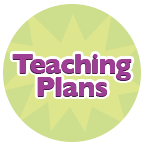Oral Language Teaching Strategy:
Encourage Partner Talk Encourage students to talk through their ideas with a partner before sharing their ideas with the group.
Time: 20–25 minutes
Materials:
– The Little Turtle by Vachel Lindsey (Shared Reading big book from Kindergarten Literacy Place for the Early Years)
– turtle and boy puppet
– optional props such as little box, mirror to represent a puddle, two or three small rocks, small piece of crumpled black paper suspended on a string to represent the bugs
Grouping: whole class and partners
Assessment: Use selected items from the Kindergarten Oral Language Assessment Scale for recording your observations.
Teaching Tip: Although the book The Little Turtle is used for this lesson, you can substitute any simple narrative for your demonstration lesson such as The Enormous Potato by Aubrey Davis. If another book is used, substitute an appropriate puppet.
BEFORE MODELLING
- Reread or re-sing The Little Turtle with the class, turning the pages of the big book to remind them of the story.
So let’s set out the props in the order we’ll need them. What do we need first? Talk about the props with your partner and decide what we need first and next.
Introduce the lesson’s focus of using puppets for story retelling. Discuss with students the characters in the story and introduce the puppets. Ask students to discuss with a partner what props will be needed to retell the story with puppets, and in which order they will need the props. Share ideas from a few partners with the class.
- Invite three students to act out the story as the class sings The Little Turtle song or rereads the book together. (One student can be the little boy, another the turtle, and the third student can bob the insects up and down on a string.)
Setting a Purpose
-
I’m going to be the turtle. Could someone help me by being the little boy and can someone else be the insects? Listen and watch because you might want to tell the story and act it out in centre time.
Establish the purpose for rereading or retelling. Tell the students that you are going to retell the story in your own words and they should listen and watch as they might want to retell the story in centre time.
DURING MODELLING
-
In the story we read the little boy doesn’t say anything. Could he say something in our story? Talk about it with your partner.
Discuss the role of the little boy and the insects. Ask the students to pretend they are the little boy and talk to a partner about what they would say at the beginning of the story when he brings the box to the pond. Ask a few of the partners to share their ideas with the class.
-
Tell me how you helped me get in the pond. What might you say to me?
Take the role of the turtle and retell the story in the first person. Bring in the little boy by building in prompts within your script.
- Bring the student representing the insects into the story too, by asking what sound a mosquito makes. (The flea could express an opinion, too!)
AFTER MODELLING
- Revisit the purpose for rereading or retelling by asking how you and the other students told the story.
- Use prompts to elicit information and ask students to discuss ideas with a partner for one or two of the prompts, and then ask a few students to share their ideas with the class:
- How did I talk like a turtle? (e.g., used ‘I,’ and used a ‘turtle voice’)
- How did I act like a turtle?
- Did we change the story? (we didn’t change the characters or events but we asked the little boy to talk and the insects to contribute)
- Did we use the same words as in the book/song? Is that okay? Why?
- Did the props help? How?
- Ask the students to think about retelling stories with puppets during centre time. Suggest that they retell The Little Turtle, and explain that you will be placing the props in the prop box for their use.
- Offer students other suggestions for story retelling, using books you have already read with the class. Consider suggesting But Mom…, Why Did the Chicken Cross the Road?, Where are the Bears? or The Very Cranky Bear.
- Place at a centre the books and recorded songs from the Shared Reading titles, together with the puppets.
Teaching Tip: Consider placing the puppets near the listening centre if Shared Reading books and audio recordings are used.
